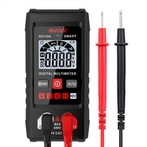Methods of Using a Digital Multimeter to Measure Whether a Wire Is Leaking Electricity
There are two methods to use a multimeter to measure whether a wire is leaking electricity to the ground: One is live measurement. Set the multimeter to the AC range. When the equipment is powered on, measure the voltage between the equipment's outer shell and the ground. A voltage of several tens of volts is generally induced electricity, and if it exceeds 100 volts, it can be determined that the equipment is leaking electricity. This detection method is generally not recommended. The second method is to cut off the power supply and measure the insulation resistance between the live wire and the neutral wire, as well as between the live wire and the ground wire. Measuring with a multimeter is not very accurate. A more accurate measurement should use a megohmmeter. When using a multimeter, generally only cases of severe leakage can be shown on the multimeter, and the resistance values usually range from several hundred ohms to several tens of ohms.
Digital Multimeter Measurement Methods
Set the multimeter to the AC range. When the equipment is powered on, measure the voltage between the equipment's outer shell and the ground wire (make sure it is the ground wire). If the voltage ranges from several tens of volts to 110 volts, it indicates induced electricity. If it is 220V or 380V, it indicates leakage.
Set the multimeter to the AC range. When the equipment is powered on, measure the voltage between the equipment's outer shell and the neutral wire. If the voltage ranges from several tens of volts to 110 volts, it indicates induced electricity. If it is 220V or 380V, it indicates leakage.
Strictly speaking, a megohmmeter should be used to measure the insulation resistance of the circuit and determine whether there is leakage. A megohmmeter is equivalent to a 1000V or 500V generator. The leakage current passes through the sampling resistor inside the megohmmeter, and a sampling voltage reading is generated on the resistor. Usually, a stable value greater than 0.5 megohms is considered qualified. The methods are as follows:
Power off the equipment, fully discharge it, take safety measures and hang warning signs, and then disconnect the terminals on both sides of the cable for measurement. It is absolutely not allowed to conduct measurements while the equipment is live to ensure the safety of personnel and equipment.
Before measurement, check whether the megohmmeter is in normal working condition, mainly checking its "0" and "∞" positions. That is, shake the handle to make the motor reach the rated speed. The megohmmeter should point to the "0" position when short - circuited and the "∞" position when open - circuited.
Connect the "L" terminal to the conductor of the device under test, the "E" ground terminal to the grounded outer shell of the device, and the "G" shield terminal to the insulating part of the device under test. Rotate the megohmmeter at a constant speed of 120 revolutions per minute. If the reading is stably greater than 0.5 megohms, it is qualified; otherwise, the insulation is insufficient, and there may be leakage.






